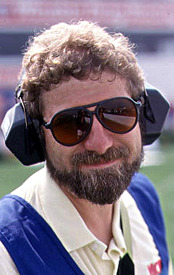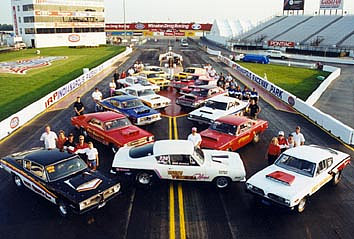 HEMI
THUNDER OVER INDY HEMI
THUNDER OVER INDY
by Geoff Stunkard. DRO file photo by Jeff
Burk
Editor's Note: Geoff Stunkard has been covering Chryslers and drag
racing for many years and is an acknowledged expert. This month, instead
of his usual memorabilia column, we asked him to write a piece about
these "collectible" cars which come out to race on occasion.
The Year 2000 U.S. Nationals SS/AA Class Championship Few traditions
in Sportsman drag racing match the excitement found in SS/AA class eliminations
at Indianapolis Raceway Park during the U.S. Nationals. At this year's
46th Annual event, no less then 18 SS/AA 1968 Hemi A-bodies were on
hand, drawn in by both the notoriety that accompanies Indy and a substantial
purse put together by racer Eddie Smith.
 Smith,
whose S&S Racing fielded three SS/AA cars this year, organized sponsors
who posted funds for the winner and runner-up spots, plus qualifying
money. For those of you who might not know, the SS/AA cars were originally
constructed by Hurst for Chrysler in 1968 using 426 Race Hemi engines
in the small A-body Plymouth Barracuda and Dodge Dart. Rare today, clones
make up a majority of the cars competing in the class. They are the
quickest of the pure Super Stock entries in NHRA or IHRA competition,
noted for their high wheelstands, and represented the largest class
of Sportsman cars by far at this year's event. Smith,
whose S&S Racing fielded three SS/AA cars this year, organized sponsors
who posted funds for the winner and runner-up spots, plus qualifying
money. For those of you who might not know, the SS/AA cars were originally
constructed by Hurst for Chrysler in 1968 using 426 Race Hemi engines
in the small A-body Plymouth Barracuda and Dodge Dart. Rare today, clones
make up a majority of the cars competing in the class. They are the
quickest of the pure Super Stock entries in NHRA or IHRA competition,
noted for their high wheelstands, and represented the largest class
of Sportsman cars by far at this year's event.
By the time that Friday's Super Stock class racing began, three of
the 18 (including Smith himself) had reluctantly pulled out of the event
due to parts damage, but the remaining 15 entries were ready to go.
Low ET of that first round came from Bucky Hess with a 9.08, followed
by Richard Beshore with a 9.09 and Dean Nicopolis (in one of Smith's
cars) with a 9.11. Also winning were David Barton (9.17), Sid Bonnecarrere
(9.23), "Little Joe" Teuton (9.25), Randy Hopkins (9.35) and Low SS/AA
qualifier Dave Raybourn (12.13 single).
When round two began about 90 minutes later, things got more interesting.
Two of the quickest racers in the class, Hess and Teuton, had won but
were late in reporting to the staging area due to mechanical problems.
Despite the thrash to get ready, both were unable to get in line for
the round due to the large number of Super Comp entries blocking the
back of the lanes. As a result, they were both disqualified, this despite
the fact that Teuton had managed to arrive via the return road and pull
toward the burnout area even as the final pair of the other six entries
were crossing the finish line.
Hess never got beyond the back of staging. Starter Rick Stewart made
the tough call, much to the disappointment of Teuton's crew and onlookers,
but, as they say, he's the boss out there. In his defense, Stewart made
the call noting that Teuton had not yet suited up and wasn't actually
"ready to race" the second he arrived on the starting line.
Of the cars that did race, advancing to the semifinals were the "Killer
B's" - Beshore, Bonnecarrere and Barton.
That semifinal round produced one of the closest races of the entire
weekend. Sid Bonnecarrere got the jump in his Cajun Flyer Dodge (.553
to .623), but David Barton had a little more horsepower and his red
Dart crossed the finish line only two inches in front of Sid (9.190
to 9.261) to win by .001 (one thousandth of a second)! Beshore clocked
an easy 16.82 to single for the other final round berth.
So, the money round came down to second-generation racer David Barton,
son of Hemi guru Ray Barton, in a just-completed Dart and Dr. Beshore's
Barracuda that was this year's Gatornationals runner-up. Young Barton
strapped a nice holeshot (.512 to .574) on the Michigan-based Plymouth,
and Beshore was reeling the Dart at the top end. Unfortunately, his
quicker 9.122 was still not enough to beat Barton's comparable 9.137,
and the prize and fame went back to Pennsylvania to the Barton shop
by a margin of .047.
One would think that with the advent of the GT classes, these non-aero
32-year-old dinosaurs would disappear. Indeed, Chrysler engineers Dick
Maxwell and Tom Hoover have stated that NHRA never forgave them for
building the cars. Based on the number of entries at Indy this year
and the cars' continued appeal to spectators, even detractors have to
agree that the 1968 "A-Bombs" will be with us for a long time to come.
|